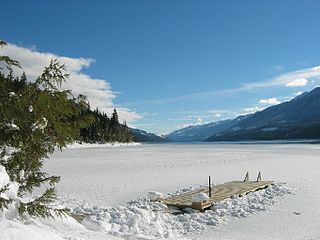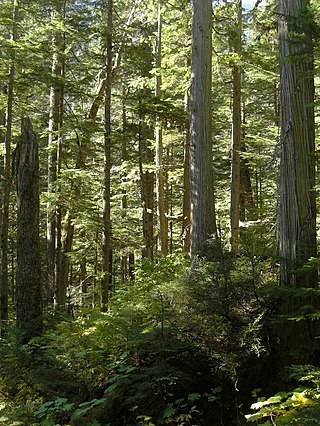The Nakusp and Slocan Railway (N&S) is a historic Canadian railway that operated in the West Kootenay region of southeastern British Columbia. The N&S initially connected Nakusp and Three Forks but soon extended to Sandon.

Canal Flats is a village municipality in the East Kootenay region of southeastern British Columbia. This Columbia Valley community lies between the southern end of Columbia Lake and the northwest shore of the Kootenay River. The locality, on Highway 93/95, is by road about 83 kilometres (52 mi) north of Cranbrook and 165 kilometres (103 mi) southeast of Golden.

Trout Lake is a ribbon lake in the West Kootenay region of southeastern British Columbia. Between the Selkirk Mountains to the west and the Purcell Mountains to the east, the lake is about 23 kilometres (14 mi) long and 1.6 kilometres (1 mi) wide. Lardeau Creek flows into the northern end and Lardeau River flows from the southern end. BC Highway 31 skirts the northeast shore. The northern end is about 90 kilometres (56 mi) by road and ferry southeast of Revelstoke.

Fort Steele is a heritage site in the East Kootenay region of southeastern British Columbia. This visitor attraction lies on the east shore of the Kootenay River between the mouths of the St. Mary River and Wild Horse River. The locality, on the merged section of highways 93 and 95, is by road about 17 kilometres (11 mi) northeast of Cranbrook and 230 kilometres (143 mi) southeast of Golden.
Winlaw is an unincorporated community adjacent to Winlaw Creek on the east side of the Slocan River in the West Kootenay region of southeastern British Columbia. The locality is on BC Highway 6 about 20 kilometres (12 mi) south of Slocan, and 49 kilometres (30 mi) north of Castlegar.
The Duncan River is in the West Kootenay region of southeastern British Columbia. Entering the North Arm of Kootenay Lake, the river is a major tributary of the Kootenay River, which in turn flows into the Columbia River. The Selkirk Mountains lie to the west and the Purcell Mountains to the east.
Boswell is an unincorporated community in the West Kootenay region of southeastern British Columbia. The former steamboat landing and temporary ferry terminal is adjacent to McGregor Creek on the east shore of the south arm of Kootenay Lake. Comprising a few kilometres stretched along BC Highway 3A, the location is by road about 48 kilometres (30 mi) north of Creston and by road and ferry about 76 kilometres (47 mi) southeast of Nelson.

The Incomappleux River is in the West Kootenay region of southeastern British Columbia, Canada. Entering the Beaton Arm of Upper Arrow Lake, the river is a major tributary of the Columbia River. The upper reaches of the Incomappleux valley are home to some of the only inland temperate rainforest in the world.
Lardeau is an unincorporated community, and former mining town and steamboat landing. The settlement is on the west shore near the head of Kootenay Lake in the West Kootenay region of southeastern British Columbia.
Trout Lake is an unincorporated community in the West Kootenay region of southeastern British Columbia. The former steamboat landing is at the north end of Trout Lake. The locality, on BC Highway 31, is by road about 177 kilometres (110 mi) north of Nelson and 90 kilometres (56 mi) by road and ferry southeast of Revelstoke.

Galena Bay is an unincorporated locality, on the bay of the same name, at the head of Upper Arrow Lake in the West Kootenay region of southeastern British Columbia.
Wasa is an unincorporated community in the East Kootenay region of southeastern British Columbia. This place, on the east shore of the Kootenay River north of the mouth of Lewis Creek, surrounds Wasa Lake. The locality, on the merged section of highways 93 and 95, is by road about 36 kilometres (22 mi) north of Cranbrook and 211 kilometres (131 mi) southeast of Golden.
Camborne is a ghost town in the West Kootenay region of southeastern British Columbia. The former mining community was at the mouth of Pool Creek on the east side of the Incomappleux River. The locality is about 78 kilometres (48 mi) by road north of Nakusp and 91 kilometres (57 mi) by road and ferry southeast of Revelstoke.
Procter is an unincorporated community in the West Kootenay region of southeastern British Columbia. The former steamboat landing is on the south shore at the entrance to the West Arm of Kootenay Lake. By road and ferry, the locality is about 35 kilometres (22 mi) northeast of Nelson.
Johnsons Landing is an unincorporated community in the West Kootenay region of southeastern British Columbia. The former steamboat landing comprises scattered rural properties adjacent to the mouth of Gar Creek. To the north is Gardner Creek and to the south is Fry Creek, the three creek mouths on the northeast shore of Kootenay Lake. The locality, via BC Highway 31 and Argenta Rd, is about 121 kilometres (75 mi) northeast of Nelson.
Ferguson is an unincorporated community in the West Kootenay region of southeastern British Columbia. The near ghost town is immediately northwest of the confluence of Ferguson Creek into Lardeau Creek. The locality, on Ferguson Rd and off BC Highway 31, is by road about 183 kilometres (114 mi) north of Nelson and 96 kilometres (60 mi) by road and ferry southeast of Revelstoke.
Poplar Creek is a ghost town in the West Kootenay region of southeastern British Columbia. The former mining community is at the mouth of Popular Creek on the southwest side of the Lardeau River. The locality, on BC Highway 31, is about 37 kilometres (23 mi) northwest of Lardeau and 16 kilometres (10 mi) southeast of Gerrard.
Gerrard is a ghost town in the West Kootenay region of southeastern British Columbia. The settlement was at the south end of Trout Lake, east of Upper Arrow Lake.
Gold Hill or Goldhill is a ghost town in the West Kootenay region of southeastern British Columbia. The former mining community is on the northeast side of the Lardeau River. The locality, on BC Highway 31, is about 32 kilometres (20 mi) northwest of Lardeau and 21 kilometres (13 mi) southeast of Gerrard.
Lemon Creek is an unincorporated community on the east side of the Slocan River in the West Kootenay region of southeastern British Columbia. The locality is on BC Highway 6 about 8 kilometres (5 mi) south of Slocan, and 62 kilometres (39 mi) north of Castlegar.





